Innovation Insight: DTCC’s Project Ion
By DTCC Connection
In August, DTCC announced that Project Ion, a new initiative designed to leverage distributed ledger technology (DLT), became operational in pilot as an MVP (minimum viable product), providing a parallel record and infrastructure for over 100,00 bilateral transactions settling daily in the DTC classic settlement system — with as many as 160,000 transactions being recorded on a peak day. The existing “classic” DTC settlement system remains the authoritative source of books and records for all securities transactions and is responsible for processing the movements of cash and securities.
This private, permissioned platform was developed in collaboration with many of the world’s leading market participant and technology provider firms.
DTCC Connection sat down with Karen Duffy, DTCC Managing Director, IT Infrastructure, and Michele Hillery, General Manager of DTCC Equity Clearing and DTC Settlement Services, to learn more about DTCC’s innovations in technology, and the development of Project Ion as one of the largest DLT initiatives in equities settlement across the financial services industry today.
DC: What is Project Ion?
MH: Project Ion is a new initiative designed to leverage DLT for settlement while upholding the DTCC’s rigorous resiliency and safety standards. Currently in pilot as an MVP (minimum viable product), Project Ion provides a parallel book for daytime bilateral deliveries of equity securities between DTC participants on the DTC classic settlement system.
The existing “classic” DTC settlement system, which we know as our traditional settlement system, remains the authoritative source and is responsible for processing the actual movement and exchange of cash and securities.
KD: In essence, the MVP of Project Ion is designed to act as a parallel book and infrastructure, demonstrating the ability to reflect specific activity as it is occurring in our DTC classic system. It also demonstrates scalability, recording a peak of 160,000 transactions on a peak day. It is not facilitating any transaction processing, but we are very pleased with the progress of this initiative — one of the largest DLT implementations to date.
It is also important to note that the platform used by Project Ion is hosted and managed at DTCC, which was critical for us to ensure the safety and security of the system.
DC: Do clients need the Project Ion settlement platform to achieve accelerated settlement of T+1 for the industry?
KD: No. The industry, in coordination with regulators, is preparing to shorten the U.S. standard settlement cycle for securities to T+1 in 2024, but Project Ion is not related to those efforts specifically. That said, Project Ion is being built to support the same settlement timeframes as DTC’s classic systems and is being delivered as settlement time agnostic, including T+1, T+2, T+0 and more.
“WHAT IF WE COULD REDESIGN THE CLEARANCE AND SETTLEMENT INFRASTRUCTURE FROM THE GROUND UP, WITH NO PRE-CONCEIVED NOTIONS, LIMITATIONS, OR PROCESSES — WHAT WOULD IT LOOK LIKE?” — Michele Hillery, DTCC
DC: There’s a lot of discussion about atomic settlement, real-time gross settlement (RTGS), and T+0. Are these all the same things and how do they relate to Project Ion?
MH: This has caused a bit of confusion because some people have used the terms interchangeably, but they speak to different settlement cycles. Atomic settlement is the immediate and simultaneous delivery of digital securities versus cash on a DLT whereas RTGS is the same concept, except it involves traditional assets — not digital ones. T+0 is considered end-of-day settlement on trade date. What all three of these accelerated settlement approaches have in common is that they would require a significant overhaul of the existing infrastructure, including changes to business models, regulatory reform and perhaps even the adoption of real-time currency movements. The industry has made it clear that the focus at this time is moving to T+1 as an industry standard settlement cycle.
That said, there are some firms in the industry who are settling on faster timeframes, even today, leveraging DTC classic systems based on their own needs and processes — but there isn’t consensus on an entire industry move to anything beyond T+1 now.
From a Project Ion perspective, Project Ion is being built to support a netted T+0 settlement cycle, as well as T+2, T+1 and extended settlement cycles. Project Ion is not being developed to support atomic settlement or RTGS at this time, until there is consensus that these are capabilities that the industry needs.
DC: Why does DTCC think it’s important to invest in emerging technology like DLT?
KD: We believe investments in fintech solutions can enable market infrastructure providers to not only modernize infrastructure, but also deliver new value and capabilities while protecting the global financial system. DTCC’s goal — as it has always been — is to invest in technology to deliver the highest value and capabilities to our clients while delivering all the safety, resiliency, and soundness that we are known for.
For the Project Ion effort, DTCC partnered with a leading enterprise technology provider R3 to develop and launch the Project Ion platform, leveraging R3’s Corda DLT software.
DC: What’s next for DTCC in terms of modernizing processes and Project Ion?
MH: As part of DTCC’s modernization efforts, we’re rethinking how to optimize processes across the entire company using existing technology, updating processes, and adopting newer fintech. Our focus is on developing innovative strategies that incorporate updated, flexible, modern, and scalable technology to improve processes, reduce cost and risk, and enhance efficiencies for DTCC and our clients.
We’ve approached our modernization strategy with a blank whiteboard: what if we could redesign the clearance and settlement infrastructure from the ground up, with no pre-conceived notions, limitations, or processes — what would it look like? Where are the inefficiencies and points of friction today? How can we leverage tech investment and innovation to deliver operational efficiency and business resiliency across our services? How can we leverage the power of data and cloud infrastructure to deliver new value? There is a lot of exciting work ahead, and the Project Ion MVP is only the beginning.
KD: With the MVP Project Ion pilot now live, DTCC is working closely with our broker/dealer and bank clients on designing a phased expansion and enhancement of the service to address client and industry needs and feedback.






